
Imagery Analysis of Rail and Road Traffic Between Dandong and Sinuiju and the Effects of Covid-19
Key Findings
- Satellite imagery supports open-source reporting that the North Korea-China border has likely been closed to trade since January 2020 due to the North Korean government’s precautions against the transmission of the Covid-19 virus.
- Comparison of imagery from September 2019 and April 2020 shows that vehicular traffic between the Sinuiju and Dandong Customs stations decreased dramatically by approximately 88 percent since the Covid-19 outbreak and the subsequent border closure. Rail yards and customs areas have also been inactive.
- However, a recent increase in the volume of rail cars in the Dandong and Sinuiju Customs areas, as well as the removal of protective coverings at the Sinuiju rail terminal and freight yard (between March 31 and April 1), suggest preparations to resume exports to China that would provide North Korea with some hard currency.
- The resumption of exports and imports from both countries may pose a risk of virus transmission.
Overview
As a precaution against the transmission of the Covid-19 virus, North Korea took the drastic step of shutting its border with China on January 21, 2020.1 Since then, bilateral trade reportedly decreased by more than 80 percent in 2020. North Korea’s exports to China fell by more than 77 percent, while its imports fell by 80 percent.2 The border shutdown, now well over one year, has already had significant impacts on the North Korean economy. In 2020 alone, North Korea’s economy is estimated to have contracted by up to 10 percent, marking North Korea’s largest annual slide since the famine in 1992, when the economy shrank by 7.1 percent.3 Should it continue through the end of this year, the impact on the North Korean people and economy could be unprecedented. To better understand the situation on the ground, CSIS Beyond Parallel conducted a satellite imagery study of rail and vehicular traffic at the Dandong-Sinuiju ports of entry, which are often cited as important indicators of the health of Chinese-North Korean political relations and the economic cooperation between the two nations.
Detailed quantification of this traffic presents several technical and practical limitations, and both nations seek to limit the ability of outsiders to monitor the traffic by restricting critical activity to hours of low visibility in satellite imagery and using large rail sheds to cover the presence of rail cars, their numbers, and types. A preliminary survey using and comparing satellite imagery from 2019 to 2021 presents an opportunity to begin to develop some broad trends that may be useful in understanding the effects of Covid-19 on the trade between the two nations from the onset of the pandemic to today.4
Background
While both Dandong and Sinuiju are cities where a significant level of rail activity would typically be expected, the size of the rail facilities constructed in both cities exceeds what would normally be expected for cities of their sizes and is an indicator of their importance to China-North Korea trade. The rail yards in both countries are comprehensive facilities located directly on either side of the Yalu River and adjacent to the Sino-North Korean Friendship Bridge. Each contains passenger and freight terminals (including large, covered rail sheds), service facilities, warehouse areas, and customs stations.
North Korea closed its border in January 2020, soon after the Covid-19 outbreak was confirmed in Wuhan. The closure has had devastating impacts on the North Korean economy; during his closing address at the Sixth Conference of Cell Secretaries of Workers’ Party of Korea (WPK) earlier this month, Kim Jong-un described North Korea’s current economy as akin to its infamous famine in the 1990s, calling the nation to “wage another more difficult ‘Arduous March.’” The head of a transportation company handling cross-border trade recently told Reuters that the Sino-North Korean Friendship Bridge would partially reopen for cargo train service “sometime before or after May 1.”
Analysis
This brief survey of the cross-border trade between China and North Korea looks at satellite imagery of both Dandong and Sinuiju from September 2019 to March 2021. The area was divided into seven broad areas for observation: in Dandong, the freight yard, secondary rail yard, customs stations, and truck yard. In Sinuiju, the rail terminal and freight yard, customs station, truck yard, and truck staging area were observed.
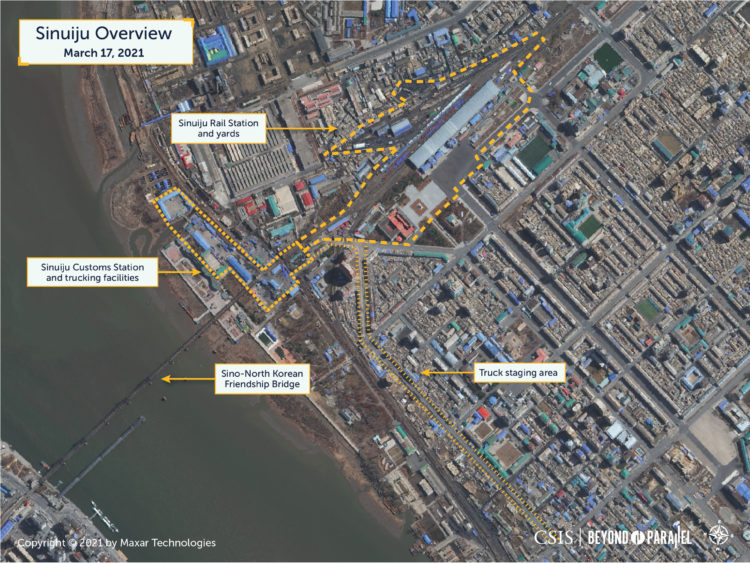
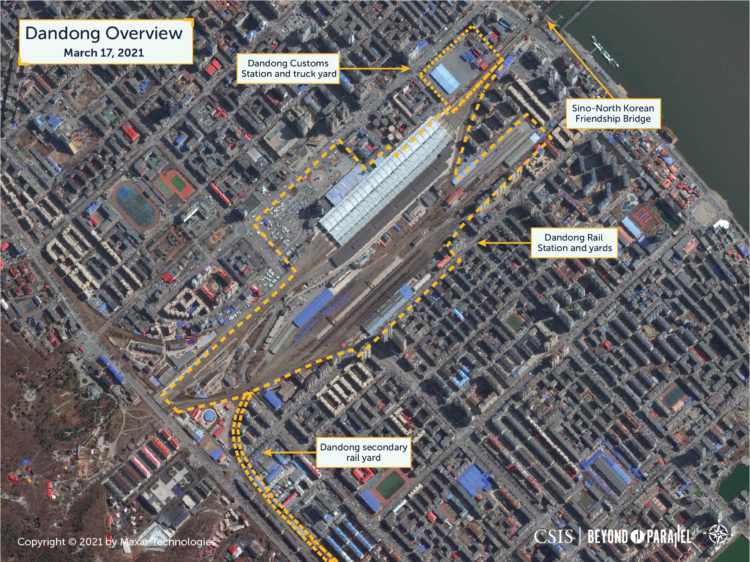
The imagery indicates significant truck traffic in both Customs stations with what appears to be more from Sinuiju to Dandong on September 3, 2019, before the Covid-19 outbreak. In imagery from April 3, 2020, after the start of the outbreak and the January border closure, vehicle traffic dramatically decreased by approximately 88 percent on both sides of the border, with only a few vehicles present in either Customs area. A recent image from March 31, 2021, indicates that truck traffic in either direction continues to be dramatically reduced.
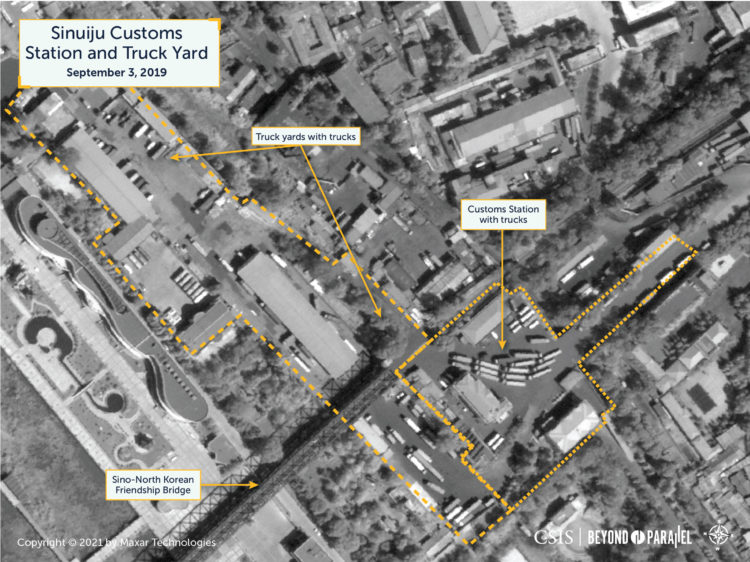
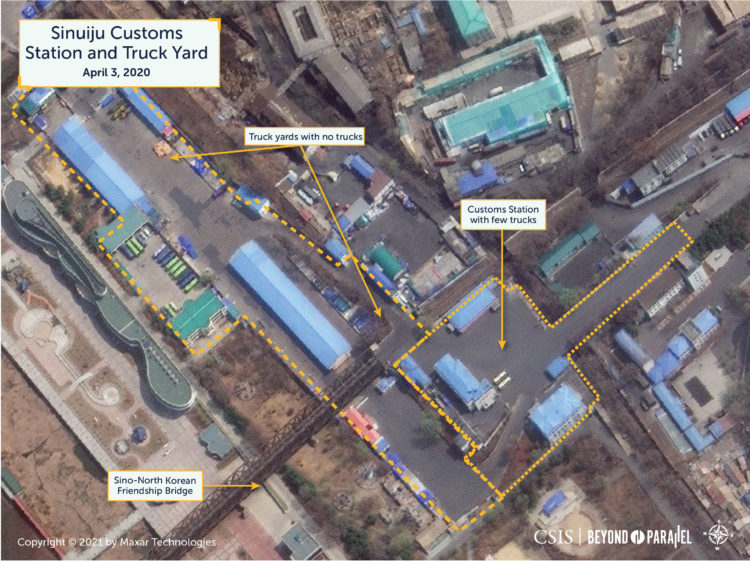
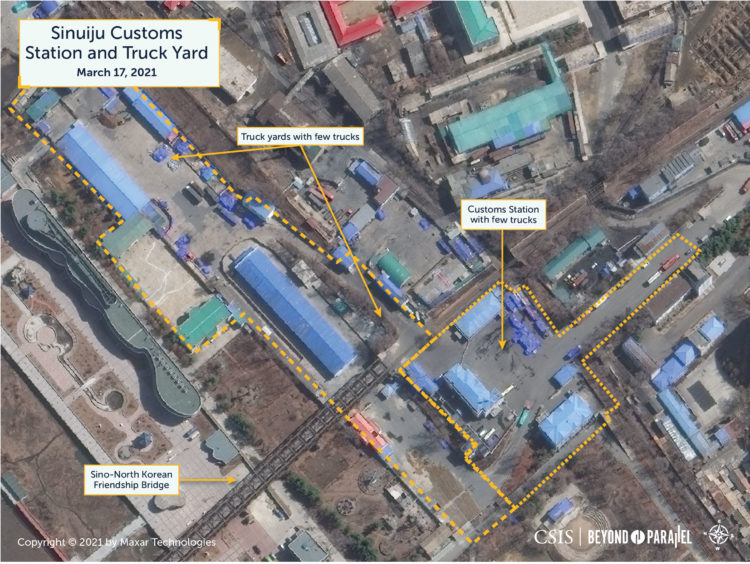
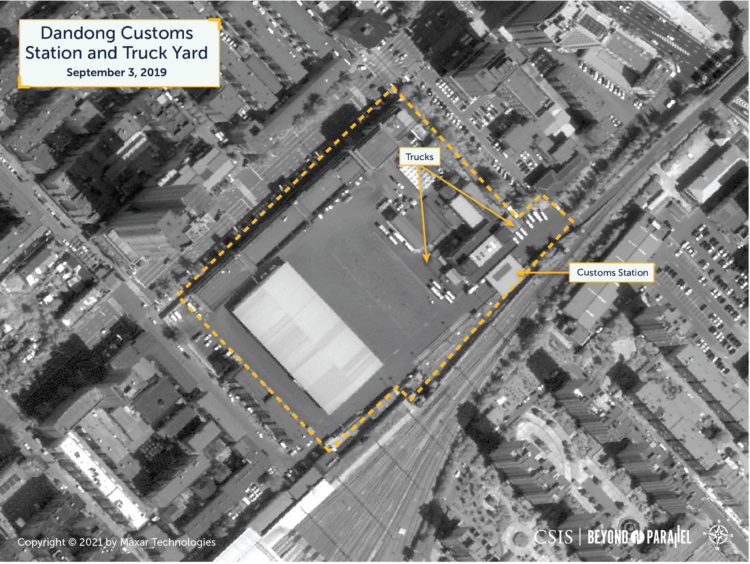
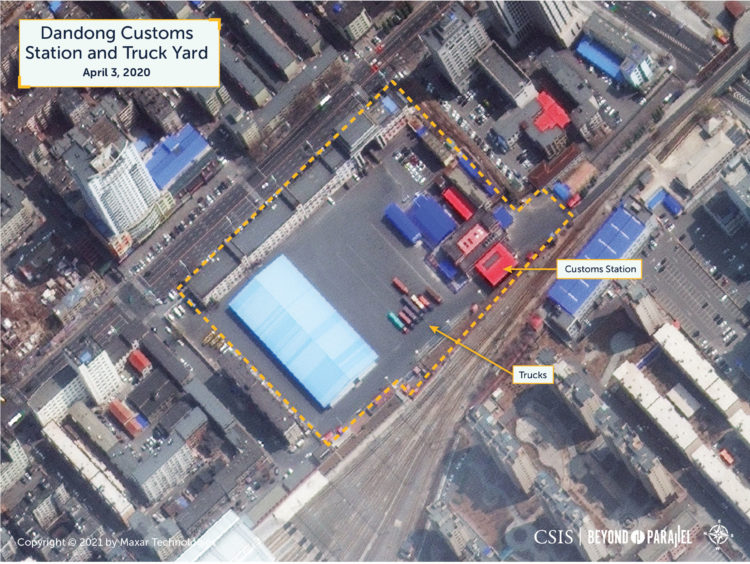

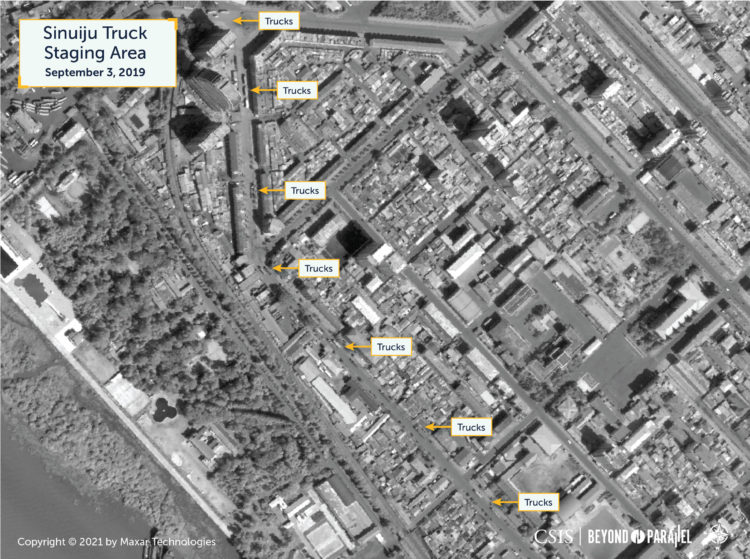

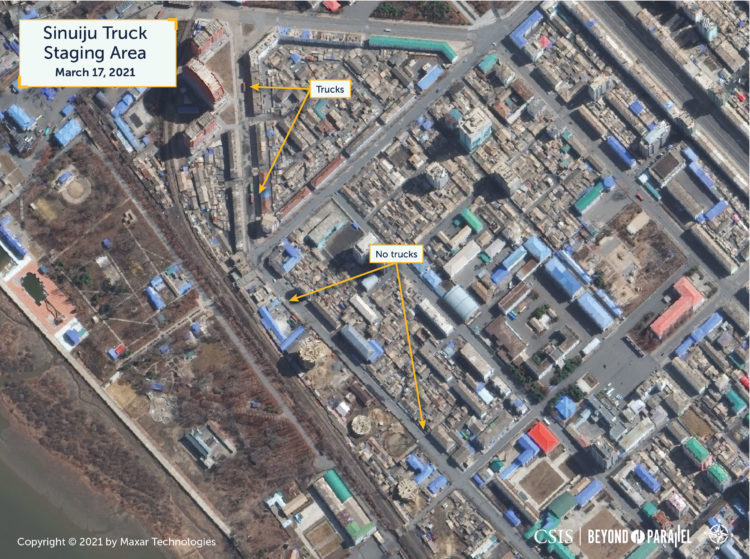
Vehicles Present in Dandong and Sinuiju Customs Areas
| 2019-09-03 | 2020-04-03 | 2021-03-17 | |
| Dandong | 18 | 8 | 0 |
| Sinuiju | 95 | 5 | 15 |
| Total | 113 | 13 | 15 |
However, a recent image of rail traffic shows an increase in the volume of rail cars present. Rail car counts more than doubled compared to the number in September 2019 and nearly doubled compared to the count at the onset of the Covid-19 outbreak in April 2020. Additionally, a temporary plastic cover was erected over one of the storage tracks on the east side of the Sinuiju railyard during mid-October 2020. The cover appears to have been erected to protect the cargo being carried in covered flat or gondola cars for export to China that were stranded due to the closure of the border as a result of Covid-19. On April 24, 2021, Voice of America reported that one of the covers in the Sinuiju rail terminal and freight yard was removed between March 31 and April 1. The removal of the protective covering appears to signal that rail trade between China and North Korea will resume in the near future and that these cars will be shipped to China.


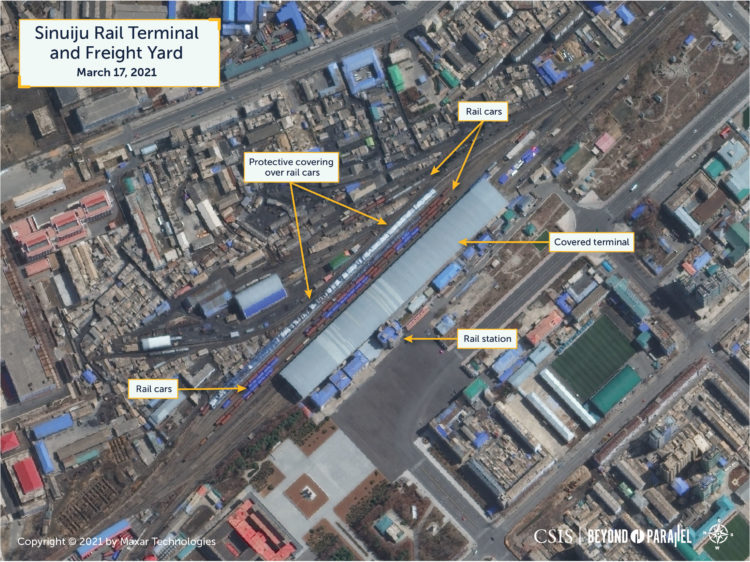
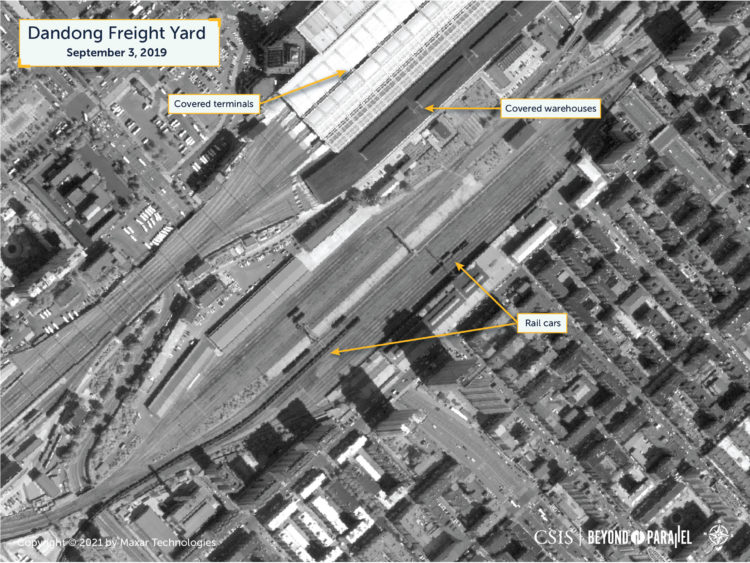

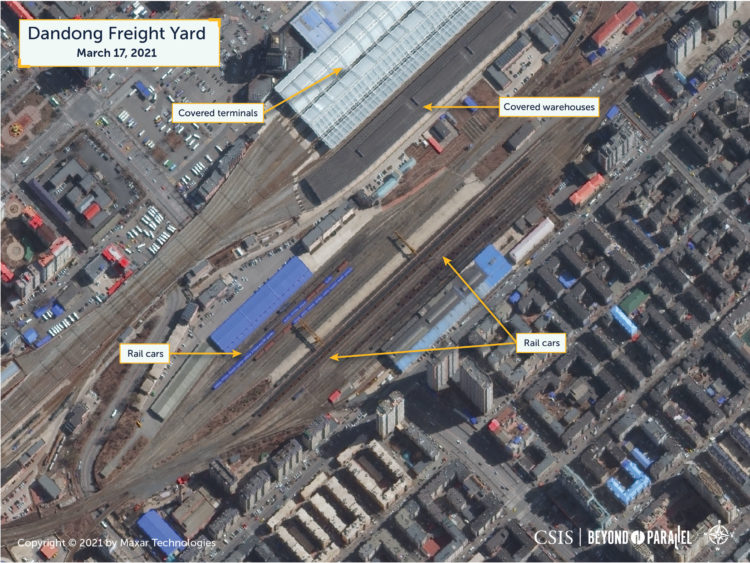
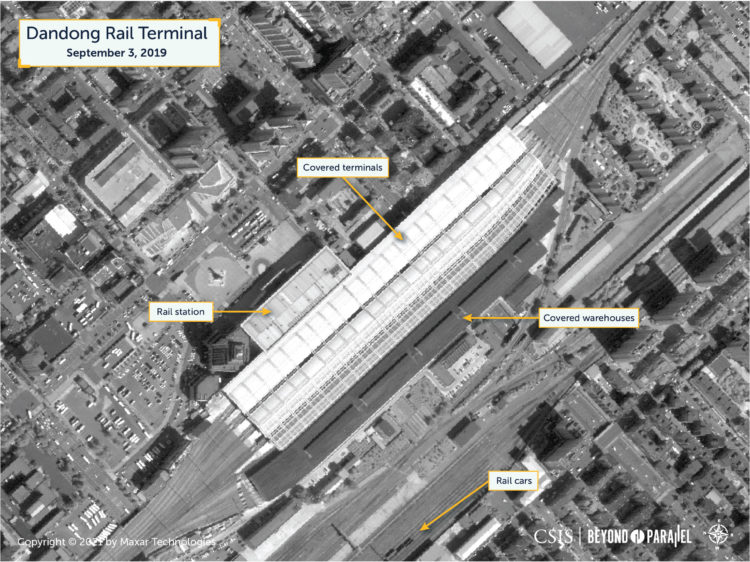
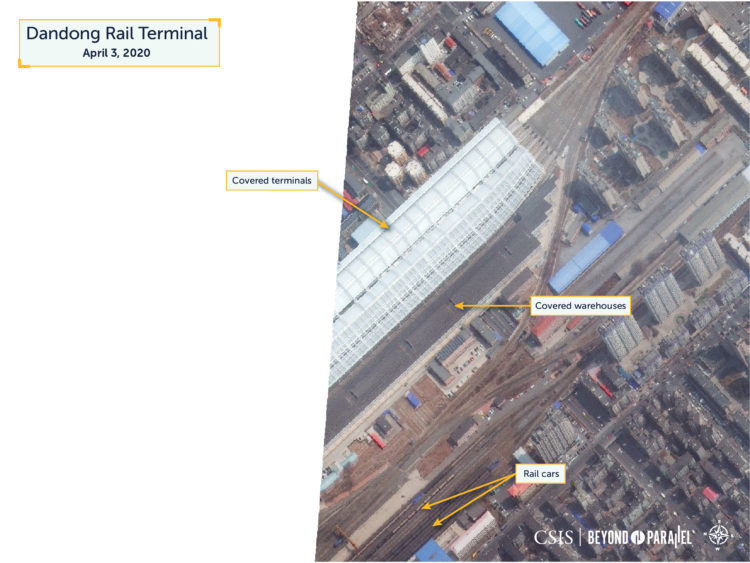
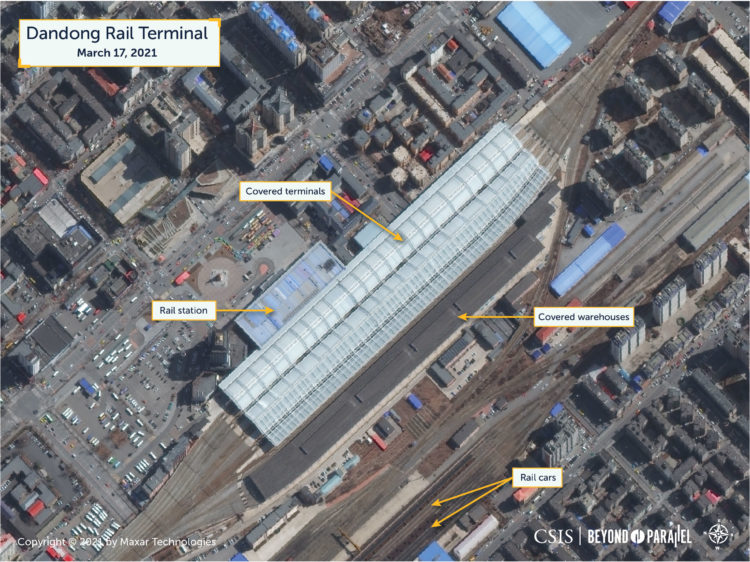
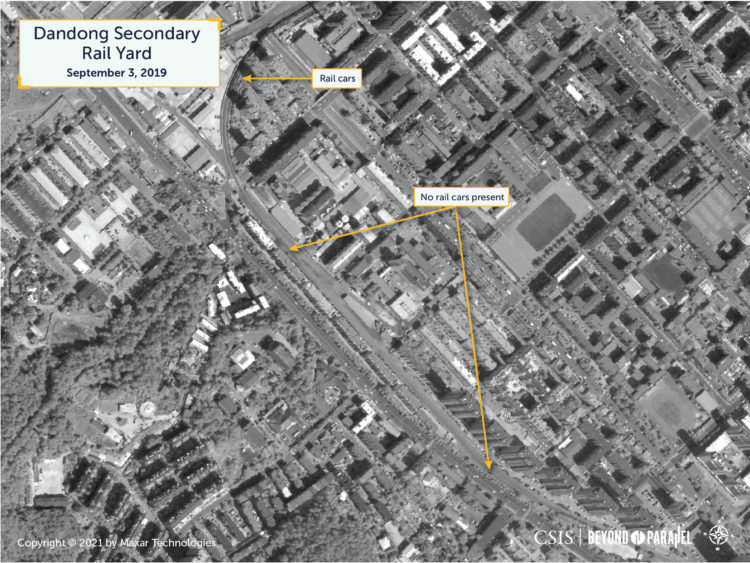
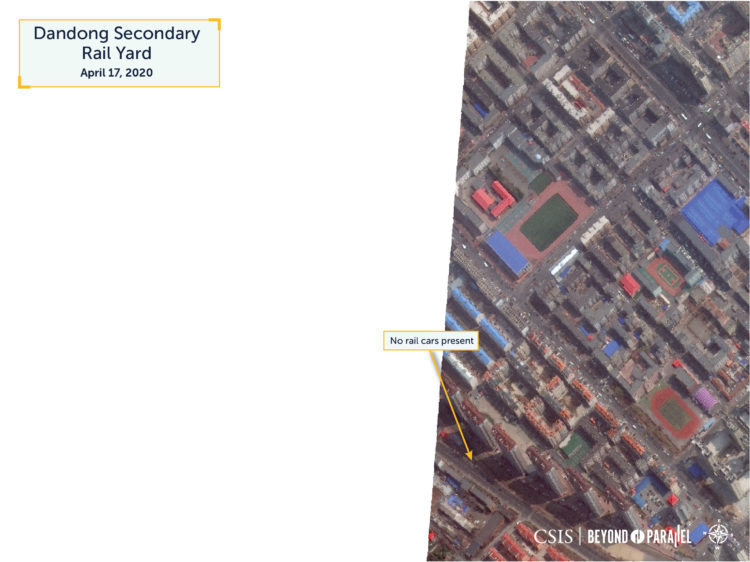
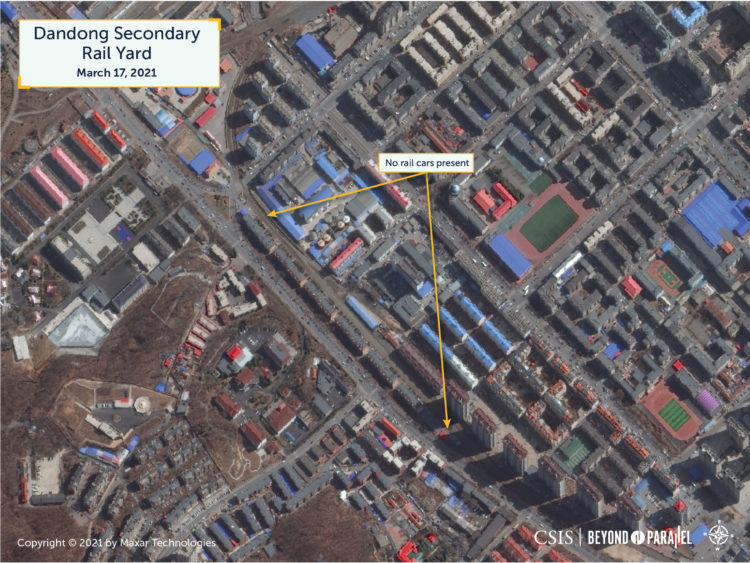
Railcars Present in Dandong and Sinuiju Rail Yards
| 2019-09-03 | 2020-04-03 | 2021-03-17 | |
| Dandong | 48 | 60* | 155 |
| Sinuiju | 62 | 92 | 130 |
| Total | 110 | 152 | 285 |
Some preliminary observations of railcar patterns by type observed at the Dandong and Sinuiju rail facilities during the period under study indicate that:
- On the Chinese side, between 65-80 percent of the rail cars observed were ore or open gondola cars, generally used to transport loose bulk or outsized cargo.
- On the North Korean side, between 55-90 percent of rail cars observed were boxcars and covered flat or covered gondola cars.
- The Dandong rail car patterns are generally smaller and less diverse (e.g., lack of tank, flat cars, etc.) than those previously observed.
- The Sinuiju car patterns are somewhat different from those previously observed (e.g., increasing size, addition and subsequent removal of a protective covering over a storage track, lack of tank cars, etc.).
Overall, the imagery confirms reports that the road and rail crossings between China and North Korea have been primarily closed during the Covid-19 crisis, that there has been a buildup of cargo for export from North Korea to China in the Sinuiju rail facilities, and that there may be some preliminary indications that the rail crossing may soon be coming to a limited reopening.
References
- Miriam Berger and Simon Denyer, “North Korea bans foreign tourists as coronavirus spreads,” The Washington Post, January 21, 2020, https://www.washingtonpost.com/world/2020/01/21/north-korea-bans-foreign-tourists-coronavirus-spreads/. ↩
- Hyonhee Shin, “N. Korea’s trade with China plunges 80% as COVID-19 lockdown bites,” Reuters, January 19, 2021, https://www.reuters.com/world/china/nkoreas-trade-with-china-plunges-80-covid-19-lockdown-bites-2021-01-19/. ↩
- Andrew Jeong, “North Korea’s Economy Hit Harder Than It Has Been in Decades,” The Wall Street Journal, December 18, 2020, https://www.wsj.com/articles/north-koreas-economy-hit-harder-than-it-has-been-in-decades-11608300202. ↩
- Earlier Beyond Parallel reports covering the Sinuiju-Dandong crossing can be found here, https://beyondparallel.csis.org/sino-north-korean-friendship-bridge-closure/ and https://beyondparallel.csis.org/making-solid-tracks-north-koreas-railway-connections-china-russia/. ↩
